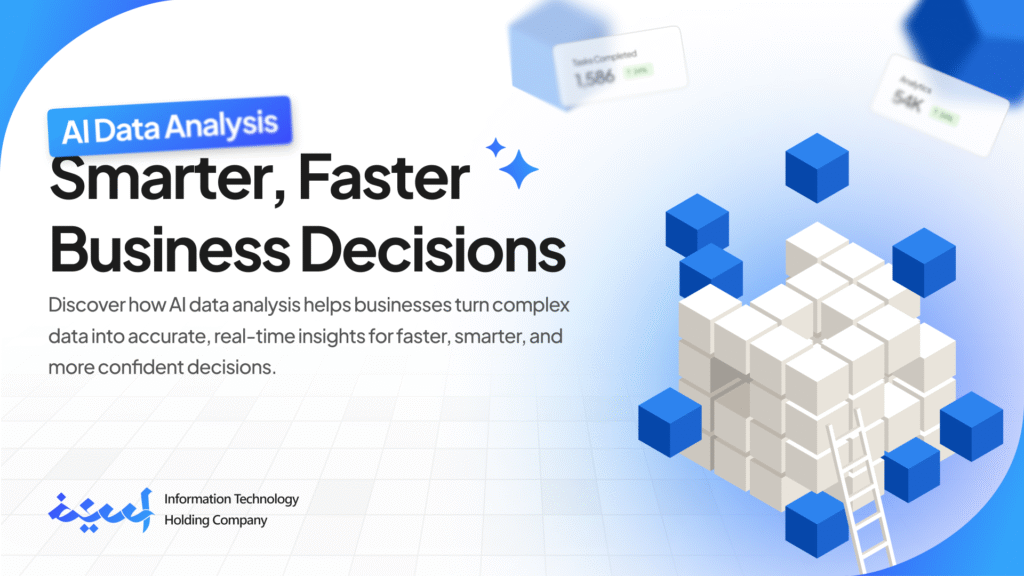
ABOUT THE AUTHOR
“Working with Aseef IT Holding Company was a seamless experience. Their team demonstrated exceptional professionalism and delivered innovative solutions that exceeded our expectations. We look forward to continuing our future projects.”
Asim Alshubrumi, CEO
Aseef IT Holding Co.
- ARTICLE

AI Data Analysis: Smarter, Faster Business Decisions
Explore how AI data analysis helps businesses turn complex data into faster, smarter decisions with real impact.
Murrafa Banday
Explore how AI data analysis helps businesses turn complex data into faster, smarter decisions with real impact.
Introduction
Every day, companies collect huge amounts of data—from websites, apps, customer feedback, and internal systems. But turning this information into smart business moves is not always easy. That’s why AI data analysis has become such a powerful tool. It helps organizations quickly understand what’s happening, what’s likely to happen next, and what to do about it.
At Aseef, we help businesses across sectors like healthcare, education, and finance use AI data analysis to improve how they work with data. From creating faster reports to predicting trends, our team builds custom solutions that save time and lead to better decisions.
Testimonials From Satisfied Clients
Clients consistently praise Aseef IT Holding Company’s work. Here are a few highlights from website redesign project:
Working with Aseef IT Holding Company was a seamless experience. Their team demonstrated exceptional professionalism and delivered innovative solutions that exceeded our expectations. We look forward to continuing our future projects.
David Reynolds, Chief Technology Officer, Nexora Solutions

What Is AI Data Analysis?
AI data analysis refers to the use of artificial intelligence technologies—such as machine learning (ML), natural language processing (NLP), and generative AI—to process large volumes of data, identify patterns, and produce meaningful insights. Unlike traditional methods, AI systems can learn from data over time, enabling faster and more accurate decision-making with minimal manual effort.
Machine learning helps uncover trends and anomalies, NLP interprets unstructured data like text or emails, and generative AI can automatically create summaries, recommendations, or visual reports.
By replacing manual work with smart automation, AI for data analysis helps organizations turn raw data into clear and useful decisions.

How Can AI Be Used with Data Analysis?
AI for data analysis enhances the entire data lifecycle—from collection and preparation to interpretation and reporting. By integrating AI tools for data analysis into data systems, businesses can move beyond reactive reporting to proactive, insight-driven decision-making.
At Aseef, we use advanced AI technologies like Microsoft Azure Machine Learning ,Google Cloud AI, and AWS SageMaker to build intelligent, scalable data solutions. These tools allow us to automate tasks such as:
Data cleansing:
To remove duplicates, errors, or irrelevant values.
Pattern recognition:
To detect trends or anomalies that might be missed by human analysts.
Natural Language Processing (NLP):
To extract insights from unstructured sources like customer reviews, emails, or RFPs.
Predictive modeling:
To forecast future outcomes and risks.
Generative AI:
To automatically create summaries, reports, or visual dashboards.
Our trusted approach involves seamlessly embedding AI into a business’s existing data pipeline—ensuring that insights flow smoothly from raw inputs to executive-ready dashboards. Whether you’re working with structured databases or real-time streams, AI-powered data analysis can adapt to your environment and deliver fast, accurate, and context-aware analysis.

Benefits of Using AI for Data Analysis
AI brings major improvements to how data is handled and understood. It helps teams save time, reduce errors, and make confident, data-driven decisions.
By automating time-consuming tasks, AI speeds up analysis and delivers insights faster than traditional methods. It also helps identify trends and patterns that may be hard to notice manually, allowing businesses to stay ahead of changes and respond quickly.
Speed
AI processes large volumes of data in minutes, helping teams respond faster to business needs and reduce delays in decision-making.
Accuracy
It minimizes human error by following consistent rules, improving the reliability of insights and boosting confidence in the results.
Forecasting
AI identifies patterns in past data to predict future trends, helping businesses make smarter plans and reduce the risk of surprises.
Automation
By handling repetitive tasks like sorting and reporting, AI saves time and lets teams focus on higher-value work.
Focus
With AI managing the routine, teams can concentrate on strategy and critical decisions, avoiding data overload and distractions.
These benefits make AI-based data analysis a practical and powerful tool for any organization that wants to work smarter with data. When set up correctly, it doesn’t just save time—it also helps teams move with clarity, confidence, and speed.
10 Min Read:
Website Design Audit: A comprehensive Audit Guide
How Aseef Helps Businesses with AI Data Analysis
At Aseef, we help companies unlock the power of their data using AI-driven analysis. From boosting performance to predicting future trends, here are some practical ways we assist businesses in making smarter decisions:
Healthcare
We support healthcare providers in analyzing patient records to find risk patterns and improve scheduling. In one project, our AI dashboards helped reduce wait times by identifying service delays, leading to smoother operations and better patient care.
Education
Aseef works with schools and colleges to track student progress. By analyzing test scores, attendance, and engagement data, we help educators spot students who need extra support early—improving student results and retention.
Logistics
We help logistics companies use AI to forecast demand, plan delivery routes, and manage inventory. One client was able to cut delivery delays and lower fuel costs by using our AI models to adjust shipments based on real-time data.
Ecommerce
Aseef helps retailers understand customer buying habits, personalize product recommendations, and manage stock better. In one case, we helped a brand optimize their promotions, increasing customer loyalty and boosting sales.
Business Operations
We assist finance teams by automating reporting, detecting unusual transactions, and forecasting revenue. One company reduced their manual reconciliation time by over 60% through our AI solutions—allowing their teams to focus on strategy and planning.
Users of AI in Data Analysis
AI in data analysis isn’t just for data scientists—it supports a wide range of users across a business. Each role uses AI insights differently to solve real problems, work more efficiently, and make better decisions.
Executives
Business leaders rely on AI-driven dashboards to track performance, forecast trends, and make quick, data-backed decisions. Instead of waiting on reports, they get real-time views of KPIs and business health.
Data Analysts
AI speeds up tasks like data cleaning, pattern detection, and report generation. Analysts use AI tools to dive deeper into data, build models, and deliver more accurate insights—faster.
Marketing Teams
Marketers use AI to segment audiences, personalize campaigns, and measure performance. Predictive models help them understand customer behavior and improve ROI.
Service Teams
From logistics to healthcare, operations teams use AI to monitor workflows, detect issues early, and optimize processes—like reducing delays or managing inventory in real-time.
IT Team
AI tools help automate monitoring, detect anomalies in system performance, and manage large-scale data infrastructure. These teams also maintain the pipelines and APIs that support AI models.

Correspondence Management System
AWJ Murasalah is a system for managing official correspondence, memos, and document workflows efficiently.
Working with Aseef IT Holding Company was a seamless experience. Their team demonstrated exceptional professionalism and delivered innovative solutions that exceeded our expectations. We look forward to continuing our collaboration in future projects.
David Reynolds, Chief Technology Officer, Nexora Solutions
Conclusion
AI is transforming the way organizations understand and use data—turning complex, raw information into smart, timely decisions. Whether it’s improving accuracy, speeding up analysis, or predicting what’s next, AI helps businesses move with clarity and confidence.
With practical experience across sectors like education, healthcare, logistics, and finance, we’ve seen firsthand how best AI for data analysis can unlock real value. From cleaning up data pipelines to building predictive dashboards, the right tools and strategies make all the difference.
Blog Summary
Every day, companies collect huge amounts of data—from websites, apps, customer feedback, and internal systems. But turning this information into smart business moves is not always easy.
AI data analysis refers to the use of artificial intelligence technologies—such as machine learning (ML), natural language processing (NLP), and generative AI—to process large volumes of data, identify patterns, and produce meaningful insights.
AI for data analysis enhances the entire data lifecycle—from collection and preparation to interpretation and reporting. By integrating AI tools for data analysis into data systems, businesses can move beyond reactive reporting to proactive, insight-driven decision-making.
AI brings major improvements to how data is handled and understood. It helps teams save time, reduce errors, and make confident, data-driven decisions.
At Aseef, we help companies unlock the power of their data using AI-driven analysis. From boosting performance to predicting future trends, here are some practical ways we assist businesses in making smarter decisions.
AI in data analysis isn’t just for data scientists—it supports a wide range of users across a business. Each role uses AI insights differently to solve real problems, work more efficiently, and make better decisions.
Frequently Asked Questions (FAQs)
Explore Our Proven Success in IT Solutions and Digital Transformation
1. How does AI data analysis work?
AI data analysis uses machine learning, NLP, and generative AI to detect patterns, interpret unstructured data, and generate reports. It automates manual tasks and delivers faster, more accurate insights for smarter decisions.
2. Why is AI data analysis becoming essential for modern businesses?
With increasing data complexity, AI helps businesses move from static, manual reporting to dynamic, predictive insights. It enables smarter decisions, quicker reactions to market trends, and automation of routine tasks.
3. How can AI be integrated into my existing data workflow or tech stack?
AI tools like Google Cloud AI, Azure Machine Learning, and AWS SageMaker can be embedded into your existing systems. At Aseef, we ensure AI complements current databases, dashboards, and BI tools with minimal disruption.
4. Is AI data analysis feasible for small and mid-sized businesses too?
Absolutely. Affordable tools like Julius.ai, Rows, and Zoho Analytics offer AI-powered insights without the need for a dedicated data science team. Aseef helps tailor solutions to fit your budget, team skill set, and business goals.
5. How can Aseef help my organization get started with AI in data analysis?
We begin with a strategic assessment and pilot implementation—whether automating reports or integrating predictive dashboards. Our team customizes tools, ensures data integrity, and trains your team for long-term success.
- Publication Date
Category
- Artificial Intelligence
Table of Contents
Ready to Transform?
Whether you’re starting your digital journey or scaling transformation, Aseef is your reliable IT consulting company in Saudi Arabia.

